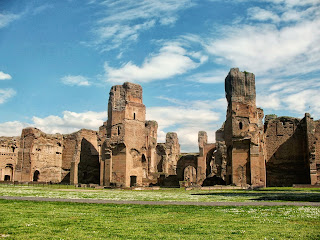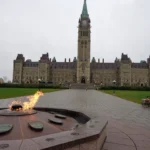
The Baths of Caracalla were constructed as a public bath house around the year 200 A.D. by Caracalla the Emperor They were the second largest public bath houses built in Rome between 212 and 217 A.D. and are located in Rome, Italy. Although some estimates suggest that due to the size of the Baths of Caracalla, construction would have taken longer – most likely from 211 to 217 A.D. The baths were designed by Septimius Severus, Caracalla’s father, but were not built until Caracalla’s reign. Emperor Caracalla built the baths in order to gain the political favor of his people. The Baths of Carcalla were used as baths until the Ostrogoths took control in the 1500s during the Gothic War. The Baths of Caracalla are now a popular tourist destination.
The Baths of Caracalla are known as Terme di Caracalla in Italian.
The word for public baths at the time was thermae.
If the Baths of Caracalla were completed in six years rather than seven, as previously suggested, more than 2,000 tons of building material would have had to be installed each day.
Baths of Caracalla were a complex, complete with bathing areas (in heated water) and a large courtyard with exercise space and changing rooms surrounding it.
There were two exercise courtyards in the Baths of Caracalla, and their pavement was decorated with black and white mosaic patterns.
There were wooden balconies overlooking the courtyard where people could watch others work out below. The balconies are gone, but there is still evidence of their presence in the brickwork where they were attached to the walls.
The natatorium or frigidarium were the cold baths in Baths of Caracalla.
The warm baths in Baths of Caracalla were known as the tepidarium, while the hot baths were known as the caldarium.
The slaves who were stuck in the basement adding coal to the ovens to keep the water hot heated the water in the baths.
Heliogabalus and Severus Alexander, Caracalla’s successors, finished some of the additional structures, including gardens, shops, massage rooms, music pavilions, and even a museum.
In 1824, a mosaic depicting various athletes was discovered in the northern hall. The mosaic is now housed in the Vatican Museum.
When it was first built, the Baths of Caracalla could accommodate 1600 people at once.
The Farnese family was granted the right to remove all valuable objects from Baths of Caracalla in the 1500s. They removed two large Egyptian grey granite bath tubs. These tubs are now on the Piazza Farnese in Rome, near the Palazzo Farnese.
Many of the original Baths of Caracalla statues and mosaics are now housed in the Vatican Museums, including the “Torso of the Belvedere.” A statue of Ajax, a Greek hero.
Despite centuries of looting, negligence, and earthquakes, the Baths of Caracalla can still be visited today and see remnants of many of the original structures.









